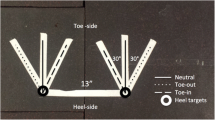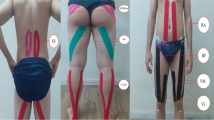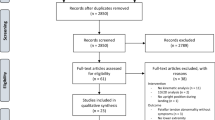Abstract
Purpose
The purpose of this study was to examine the effect of changing toe direction on knee kinetics and kinematics associated with anterior cruciate ligament injury during drop vertical jumps.
Methods
Fourteen females performed drop vertical jumps under three toe conditions (natural, toe-in, and toe-out). The knee kinetics and kinematics during landing were evaluated using a motion analysis system. Results under three toe conditions were compared using a one-way repeated measures analysis of variance and a post hoc Bonferroni test.
Results
Toe-in landing was associated with a significantly greater knee abduction angle, tibial internal rotation angle, and knee abduction moment than the natural and toe-out conditions. Toe-out landing was associated with significantly greater tibial internal rotational angular velocity.
Conclusions
Changing toe direction significantly affects knee kinetics and kinematics during landing. It is important to avoid changing toe direction excessively inward or outward during landing to prevent the increases in knee abduction and tibial internal rotation which might increase the risk of ACL injury.
Level of evidence
Prognosis, Level IV.


Similar content being viewed by others
References
Agel J, Arendt EA, Bershadsky B (2005) Anterior cruciate ligament injury in national collegiate athletic association basketball and soccer: a 13-year review. Am J Sports Med 33(4):524–530
Arendt E, Dick R (1995) Knee injury patterns among men and women in collegiate basketball and soccer. NCAA data and review of literature. Am J Sports Med 23(6):694–701
Boden BP, Dean GS, Feagin JA, Garrett WE (2000) Mechanisms of anterior cruciate ligament injury. Orthopedics 23(6):573–578
Fleiss JL (1986) The design and analysis of clinical experiments. Wiley, New York
Ford KR, Shapiro R, Myer GD, Van Den Bogert AJ, Hewett TE (2010) Longitudinal sex differences during landing in knee abduction in young athletes. Med Sci Sports Exerc 42(10):1923–1931
Griffin LY, Albohm MJ, Arendt EA, Bahr R, Beynnon BD, Demaio M et al (2006) Understanding and preventing noncontact anterior cruciate ligament injuries: a review of the Hunt Valley II meeting. Am J Sports Med 34(9):1512–1532
Grood ES, Suntay WJ (1983) A joint coordinate system for the clinical description of three-dimensional motions: application to the knee. J Biomech Eng 105(2):136–144
Hewett T, Lindenfeld T, Riccobene J, Noyes F (1999) The effect of neuromuscular training on the incidence of knee injury in female athletes—a prospective study. Am J Sports Med 27(6):699–706
Hewett TE, Myer GD, Ford KR, Heidt RS, Colosimo AJ, McLean SG et al (2005) Biomechanical measures of neuromuscular control and valgus loading of the knee predict anterior cruciate ligament injury risk in female athletes: a prospective study. Am J Sports Med 33(4):492–501
Ishida T, Yamanaka M, Takeda N, Aoki Y (2013) Knee rotation associated with dynamic knee valgus and toe direction. Knee. doi:10.1016/j.knee.2012.12.002
Koga H, Nakamae A, Shima Y, Iwasa J, Myklebust G, Engebretsen L et al (2010) Mechanisms for noncontact anterior cruciate ligament injuries: knee joint kinematics in 10 injury situations from female team handball and basketball. Am J Sports Med 38(11):2218–2225
Mandelbaum BR, Silvers HJ, Watanabe DS, Knarr JF, Thomas SD, Griffin LY et al (2005) Effectiveness of a neuromuscular and proprioceptive training program in preventing anterior cruciate ligament injuries in female athletes: 2-year follow-up. Am J Sports Med 33(7):1003–1010
Myer G, Ford K, Hewettt T (2004) Rationale and clinical techniques for anterior cruciate ligament injury prevention among female athletes. J Athl Train 39(4):352–364
Myklebust G, Engebretsen L, Braekken IH, Skjølberg A, Olsen O-E, Bahr R (2007) Prevention of noncontact anterior cruciate ligament injuries in elite and adolescent female team handball athletes. Instr Course Lect 56:407–418
Nagano Y, Ida H, Akai M, Fukubayashi T (2007) Gender differences in knee kinematics and muscle activity during single limb drop landing. Knee 14(3):218–223
Olsen O-E, Myklebust G, Engebretsen L, Bahr R (2004) Injury mechanisms for anterior cruciate ligament injuries in team handball: a systematic video analysis. Am J Sports Med 32(4):1002–1012
Olsen O-E, Myklebust G, Engebretsen L, Holme I, Bahr R (2005) Exercises to prevent lower limb injuries in youth sports: cluster randomised controlled trial. BMJ 330:449–452
Padua DA, Marshall SW, Boling MC, Thigpen CA, Garrett WE Jr, Beutler AI (2009) The Landing Error Scoring System (LESS) is a valid and reliable clinical assessment tool of jump-landing biomechanics: the JUMP-ACL study. Am J Sports Med 37(10):1996–2002
Pioletti DP, Rakotomanana LR, Leyvraz PF (1999) Strain rate effect on the mechanical behavior of the anterior cruciate ligament-bone complex. Med Eng Phys 21(2):95–100
Renstrom P, Ljungqvist A, Arendt E, Beynnon B, Fukubayashi T, Garrett W et al (2008) Non-contact ACL injuries in female athletes: an International Olympic Committee current concepts statement. Br J Sports Med 42(6):394–412
Shimokochi Y, Shultz SJ (2008) Mechanisms of noncontact anterior cruciate ligament injury. J Athl Train 43(4):396–408
Shin CS, Chaudhari AM, Andriacchi TP (2011) Valgus plus internal rotation moments increase anterior cruciate ligament strain more than either alone. Med Sci Sports Exerc 43(8):1484–1491
Viskontas DG, Giuffre BM, Duggal N, Graham D, Parker D, Coolican M (2008) Bone bruises associated with ACL rupture: correlation with injury mechanism. Am J Sports Med 36(5):927–933
Waldén M, Atroshi I, Magnusson H, Wagner P, Hägglund M (2012) Prevention of acute knee injuries in adolescent female football players: cluster randomised controlled trial. BMJ 344:e3042
Acknowledgments
The authors thank Prof. Junko Fukushima for her suggestions in the preparation of this article.
Conflict of interest
All authors have no conflicts of interest to declare.
Author information
Authors and Affiliations
Corresponding author
Rights and permissions
About this article
Cite this article
Ishida, T., Yamanaka, M., Takeda, N. et al. The effect of changing toe direction on knee kinematics during drop vertical jump: a possible risk factor for anterior cruciate ligament injury. Knee Surg Sports Traumatol Arthrosc 23, 1004–1009 (2015). https://doi.org/10.1007/s00167-013-2815-2
Received:
Accepted:
Published:
Issue Date:
DOI: https://doi.org/10.1007/s00167-013-2815-2




